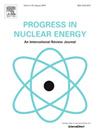The liquid droplet radiator (LDR) system can achieve a maximum heat transfer capacity of ten times that of traditional heat pipe heat exchangers per unit mass, which is very advantageous for the use of future space equipment. LDR mainly consists of a droplet generator, droplet layer, droplet collector, circulation pump, and corresponding pipelines, among which the droplet generator is the key equipment for generating the droplet layer. By using numerical and computational fluid dynamics methods, a droplet flow calculation model is developed to simulate the generation of droplets through high-frequency disturbance jet breakup in a thin atmosphere, without considering gravity. This model aims to replicate the operation of a droplet generator. After verification, the calculation result has an error of about 5%. Analyze the working fluids of silicone oil and liquid metal lithium, examining the parameters of droplet diameter d, droplet spacing s, and droplet uniformity generated by the jet under varying jet velocities, disturbance frequencies, and other working conditions. Additionally, assess the impact of each condition on the results. The results show that the diameter d of the droplet is directly proportional to the surface tension and the initial velocity of the jet, and inversely proportional to the disturbance frequency. The droplet spacing s and droplet polydispersity index λ are inversely proportional to the disturbance frequency and directly proportional to the jet velocity. The increase in surface tension and disturbance frequency can improve the uniformity of droplet flow, and the minimum droplet polydispersity index can be reduced to around 1%. Priority should be given to adjusting the jet velocity to obtain more uniform droplets to determine the working fluid. After leaving the nozzle, the jet will generate vortices, which will affect the subsequent droplet velocity. The average velocity of the droplet is about 80% of the undisturbed velocity of the jet. The analysis of jet motion characteristics and the variation patterns of droplet diameter and uniformity can provide a basis for the design of droplet generators.


